| Article ID | Journal | Published Year | Pages | File Type |
|---|---|---|---|---|
| 901248 | Behavior Therapy | 2014 | 11 Pages |
•The probability of treatment benefit method predicts individualized treatment benefit based on pretreatment characteristics•The objective of this study was to extend the probability of treatment benefit method•We illustrate this extension of the methodology using the Child and Adolescent Anxiety Multimodal Study data•Pretreatment anxiety severity and treatment condition were used as stratifying variables•Implications of the use of the probability of treatment benefit method are discussed
The objective of this study was to extend the probability of treatment benefit method by adding treatment condition as a stratifying variable, and illustrate this extension of the methodology using the Child and Adolescent Anxiety Multimodal Study data. The probability of treatment benefit method produces a simple and practical way to predict individualized treatment benefit based on pretreatment patient characteristics. Two pretreatment patient characteristics were selected in the production of the probability of treatment benefit charts: baseline anxiety severity, measured by the Pediatric Anxiety Rating Scale, and treatment condition (cognitive-behavioral therapy, sertraline, their combination, and placebo). We produced two charts as exemplars which provide individualized and probabilistic information for treatment response and outcome to treatments for child anxiety. We discuss the implications of the use of the probability of treatment benefit method, particularly with regard to patient-centered outcomes and individualized decision-making in psychology and psychiatry.
